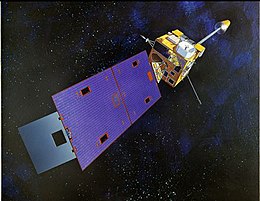GOES 9
 Artist's impression of a GOES-I series satellite in orbit | |
| Mission type | Weather satellite |
|---|---|
| Operator | NOAA/NASA |
| COSPAR ID | 1995-025A |
| SATCATno. | 23581 |
| Mission duration | 3 years (planned) 12 years (achieved) |
| Spacecraft properties | |
| Bus | LS-1300 |
| Manufacturer | Space Systems/Loral |
| Launch mass | 2,105 kilograms (4,641 lb) |
| Power | 973.0 watts |
| Start of mission | |
| Launch date | 23 May 1995, 05:52:02UTC |
| Rocket | Atlas I |
| Launch site | Cape CanaveralLC-36B |
| Contractor | ILS |
| End of mission | |
| Disposal | Decommissioned |
| Deactivated | 14 June 2007 |
| Orbital parameters | |
| Reference system | Geocentric |
| Regime | Geostationary |
| Longitude | 90° West (1995) 135° West (1996-1998) 155° East (2003-2005) |
| Slot | GOES-WEST (1996-1998) |
| Perigee altitude | 36,170 kilometers (22,470 mi) |
| Apogee altitude | 36,238 kilometers (22,517 mi) |
| Inclination | 8.7858° |
| Period | 24 hours |
GOES-9,known asGOES-Jbefore becoming operational, was an Americanweather satellite,which formed part of the U.S.National Oceanic and Atmospheric Administration'sGeostationary Operational Environmental Satellitesystem. It was launched in 1995, and operated until 2007 when it was retired and boosted to agraveyard orbit.[1][2]At launch, the satellite had a mass of 2,105 kilograms (4,641 lb), and an expected operational lifespan of three years.[3]It was built bySpace Systems/Loral,based on theLS-1300satellite bus, and was the second of five GOES-I series satellites to be launched.
Launch
[edit]
GOES-J was launched aboard anInternational Launch ServicesAtlas Irocket, flying fromLaunch Complex 36Bat theCape Canaveral Air Force Station.[4]The launch occurred at 05:52:02 GMT on 23 May 1995.[4]Following launch, it was positioned ingeostationary orbitat alongitudeof 90° West for on-orbit testing. Once this was complete, it was moved to 135° West,[5][6]where it assumed GOES-WEST operations.
Operations
[edit]GOES-9 suffered from a design fault with the motor windings in its imager and sounder, with one of two sets failing in 1997. If the other set had failed, it would have made the system inoperable. This fault also occurred on theGOES-8satellite, however it was corrected beforeGOES-10was launched.[7]
In June 1998 GOES-9 developed a problem with one of its tworeaction wheels,which were used to control its orientation. It was drawing more power than expected, and generatingnoise,visible in some of the images it returned.[5]After the other wheel started developing the same problem in July, a decision was made to replace GOES-9 with the backup satellite, GOES-10. GOES-10 took over imagery at the end of July, and reached 135° West in August.[8]Following replacement, GOES-9 was moved back to 105° West, and placed into storage as a backup.[5]It was reactivated in December 2001 for evaluation of its imager and reaction wheels, after which it was placed back into storage.
Replacement of GMS-5
[edit]In 2003, GOES-9 was reactivated again, and leased to theJapan Meteorological Agencyas a replacement for theGMS-5satellite at 155° East,[5]because its intended replacement,MTSAT-1,had failed to reach orbit. It remained in this position untilMTSAT-1Rbecame operational in November 2005, at which time GOES-9 was again deactivated and placed into storage. It was permanently retired from service and raised to a graveyard orbit on 14 June 2007.[5]
See also
[edit]References
[edit]- ^"GOES-NEWS".NASA. 2009-05-09. Archived fromthe originalon 2004-06-05.Retrieved2009-07-11.
- ^"GOES-9 Spacecraft Status Summary".NOAA. Archived fromthe originalon 2006-09-29.Retrieved2009-07-11.
- ^Krebs, Gunter."GOES-8, 9, 10, 11, 12".Gunter's Space Page.Retrieved2009-07-11.
- ^abMcDowell, Jonathan."Launch Log".Jonathan's Space Page.Retrieved2009-07-11.
- ^abcde"GOES-J Status".NOAA. Archived fromthe originalon 2004-08-07.Retrieved2009-07-11.
- ^Wade, Mark."GOES-Next".Encyclopedia Astronautica. Archived fromthe originalon February 21, 2002.Retrieved2009-07-11.
- ^"GOES Motor Windings".NASA. 2001-04-27. Archived fromthe originalon 2004-07-13.Retrieved2009-07-11.
- ^"GOES-K Status".NOAA. Archived fromthe originalon 2004-08-19.Retrieved2009-07-10.

